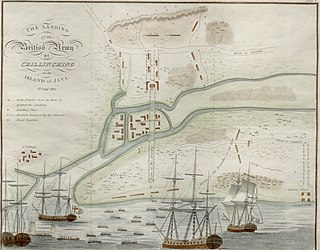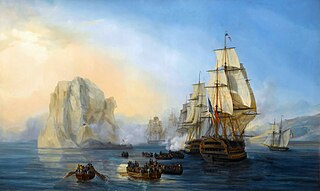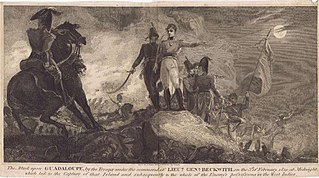Mauritius is an island nation in the Indian Ocean.
Contents
Mauritius may also refer to:
Mauritius is an island nation in the Indian Ocean.
Mauritius may also refer to:

Isle de France was a French colony in the Indian Ocean from 1715 to 1810, comprising the island now known as Mauritius and its dependent territories. It was governed by the French East India Company and formed part of the French colonial empire. Under the French, the island witnessed major changes. The increasing importance of agriculture led to the "import" of slaves and the undertaking of vast infrastructural works that transformed the capital Port Louis into a major port, warehousing, and commercial centre.

HMS Mauritius, pennant C80, was a Fiji-class light cruiser of the Royal Navy. The ship was built by Swan Hunter, Newcastle upon Tyne. She was named after Mauritius, which was a British colony when she was built and entered service in 1941.

The Invasion of Java in 1811 was a successful British amphibious operation against the Dutch East Indian island of Java that took place between August and September 1811 during the Napoleonic Wars. Originally established as a colony of the Dutch Republic, Java remained in Dutch hands throughout the French Revolutionary and Napoleonic Wars, during which time the French invaded the Republic and established the Batavian Republic in 1795, and the Kingdom of Holland in 1806. The Kingdom of Holland was annexed to the First French Empire in 1810, and Java became a titular French colony, though it continued to be administered and defended primarily by Dutch personnel.
One ship and one shore establishment of the Royal Navy have borne the name HMS Mauritius, in reference to the former colony of Mauritius:

The Mauritius Command is the fourth naval historical novel in the Aubrey-Maturin series by Patrick O'Brian, first published in 1977.

A stone frigate is a naval establishment on land.

HMD Bermuda was the principal base of the Royal Navy in the Western Atlantic between American independence and the Cold War. The Imperial fortress colony of Bermuda had occupied a useful position astride the homeward leg taken by many European vessels from the New World since before its settlement by England in 1609. French privateers may have used the islands as a staging place for operations against Spanish galleons in the 16th century. Bermudian privateers certainly played a role in many English and British wars following settlement, with its utility as a base for his privateers leading to the Earl of Warwick, the namesake of Warwick Parish, becoming the most important investor of the Somers Isles Company. Despite this, it was not until the loss of bases on most of the North American Atlantic seaboard threatened Britain's supremacy in the Western Atlantic that the island assumed great importance as a naval base. In 1818 the Royal Naval Dockyard, Bermuda officially replaced the Royal Naval Dockyard, Halifax, as the British headquarters for the North America Station (which would become the North America and West Indies Station after absorbing the Jamaica Station in 1830.

Minerve was a 40-gun Minerve-class frigate of the French Navy. The British captured her twice and the French recaptured her once. She therefore served under four names before being broken up in 1814:
The Mauritius national rugby union team represents Mauritius in international rugby union. Mauritius is a member of World Rugby, but the national team is ranked as third tier, and Mauritius have yet to compete in either the Africa Cup or Rugby World Cup.

The British Indian Ocean Territory (BIOT) is an Overseas Territory of the United Kingdom situated in the Indian Ocean, halfway between Tanzania and Indonesia. The territory comprises the seven atolls of the Chagos Archipelago with over 1,000 individual islands, many very small, amounting to a total land area of 60 square kilometres. The largest and most southerly island is Diego Garcia, 27 square kilometres, the site of a Joint Military Facility of the United Kingdom and the United States. Official administration is remote from London, though the local capital is often regarded as being on Diego Garcia.

The Mauritius campaign of 1809–1811 was a series of amphibious operations and naval actions fought to determine possession of the French Indian Ocean territories of Isle de France and Île Bonaparte during the Napoleonic Wars. The campaign lasted from the spring of 1809 until the spring of 1811, and saw both the Royal Navy and the French Navy deploy substantial frigate squadrons with the intention of disrupting or protecting trade from British India. In a war in which the Royal Navy was almost universally dominant at sea, the campaign is especially notable for the local superiority enjoyed by the French Navy in the autumn of 1810 following the British disaster at the Battle of Grand Port, the most significant defeat for the Royal Navy in the entire conflict. After their victory, the British used the original Dutch name of Mauritius for Isle de France. In 1814, Île Bonaparte was returned to France, who eventually renamed it La Réunion.

The Battle of Tamatave was fought off Tamatave in Madagascar between British and French frigate squadrons during the Napoleonic Wars. The action was the final engagement of the Mauritius campaign of 1809–1811, and it saw the destruction of the last French attempt to reinforce their garrison on Mauritius. Although the news had not reached Europe by February 1811 when the reinforcement squadron left Brest, Mauritius had been captured in December 1810 by a British invasion fleet, the French defences hampered by the lack of the supplies and troops carried aboard the frigate squadron under the command of Commodore François Roquebert in Renommée. Roquebert's heavily laden ships reached Mauritius on 6 May and discovered that the island was in British hands the following day, narrowly escaping a trap laid by a squadron of British frigates ordered to hunt and destroy them.

The Invasion of Île Bonaparte was an amphibious operation in 1810 that formed an important part of the British campaign to blockade and capture the French Indian Ocean territories of Île Bonaparte and Isle de France during the Napoleonic Wars. These islands formed a fortified base for a French frigate squadron under Commodore Jacques Hamelin to raid British convoys of East Indiamen travelling between Britain and British India. Hamelin's ships had destroyed two convoys the previous year despite the attention of a squadron of Royal Navy ships under Commodore Josias Rowley. Rowley had responded by raiding the fortified anchorage of Saint Paul on Île Bonaparte and capturing one of Hamelin's frigates and two captured East Indiamen.

The Invasion of Isle de France was a complicated but successful British amphibious operation in the Indian Ocean, launched in November 1810 during the Napoleonic Wars. During the operation, a substantial military force was landed by the Royal Navy at Grand Baie, on the French colony of Isle de France. Marching inland against weak French opposition, the British force was able to overwhelm the defenders in a series of minor engagements, culminating in the capture of the island's capital Port Napoleon and the surrender of Charles Decaen, the French governor. The surrender eliminated the last French territory in the Indian Ocean and among the military equipment captured were five French Navy frigates and 209 heavy cannon. Isle de France was retained by Britain at the end of the war under the name of Mauritius and remained part of the British Empire until 1968.

The Invasion of Guadeloupe was a British amphibious operation fought between 28 January and 6 February 1810 over control of the Caribbean island of Guadeloupe during the Napoleonic Wars. The island was the final remaining French colony in the Americas, following the systematic invasion and capture of the others during 1809 by British forces. During the Napoleonic Wars, the French colonies had provided protected harbours for French privateers and warships, which could prey on the numerous British trade routes in the Caribbean and then return to the colonies before British warships could react. In response, the British instituted a blockade of the islands, stationing ships off every port and seizing any vessel that tried to enter or leave. With trade and communication made dangerous by the British blockade squadrons, the economies and morale of the French colonies began to collapse, and in the summer of 1808 desperate messages were sent to France requesting help.
Rugby union in Mauritius is a minor but growing sport
The Raid on Griessie was a British attack on the Dutch port of Griessie on Java in the Dutch East Indies in December 1807 during the Napoleonic Wars. The raid was the final action in a series of engagements fought by the British squadron based in the Indian Ocean against the Dutch naval forces in Java. It completed the destruction of the Dutch squadron with the scuttling of three ships of the line, the last Dutch warships in the region. The British squadron—under the command of Rear-Admiral Sir Edward Pellew—sought to eliminate the Dutch to safeguard the trade route with China, which ran through the Straits of Malacca and were in the range of Dutch raiders operating from the principal Javan port of Batavia. In the summer of 1806, British frigates reconnoitred Javan waters and captured two Dutch frigates, encouraging Pellew to lead a major attack on Batavia that destroyed the last Dutch frigate and several smaller warships. Before the Batavia raid, however, Dutch Rear-Admiral Hartsinck had ordered his ships of the line to sail eastwards, where they took shelter at Griessie, near Sourabaya.
Four vessels of Britain's Royal Navy have borne the name HMS Dominica, named for the island of Dominica.
Several ships have been named Northumberland after the English county of Northumberland, or the Dukedom of Northumberland:

Imperial fortress was the designation given in the British Empire to four colonies that were located in strategic positions from each of which Royal Navy squadrons could control the surrounding regions and, between them, much of the planet.